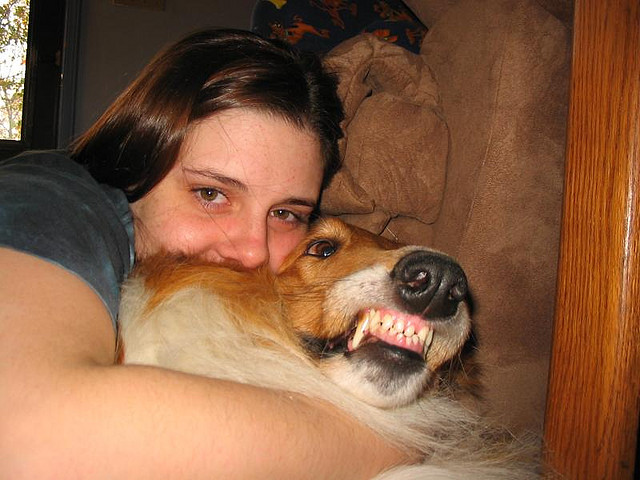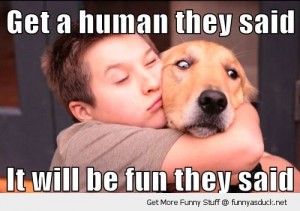No one asks Santa for dog bites or resolves to get one in the new year.
During the holidays, nothing can top the feeling of being surrounded by family and friends, enjoying delicious homemade food, and watching children play with their new treasures. Undoubtedly, many of us know of someone who received a special holiday puppy this year, and as the holidays wind down, some of these people (many of whom are parents) are suddenly facing the “now what?” moment of integrating their new dog into their everyday lives. In larger families, some of the children are indifferent to the pup while others want to smother the little guy with kisses. Unfortunately, dogs don’t always react the way that teddy bears do. Oftentimes, immediately after the holidays, there will be an increase in dog bites that are both reported and not-reported; however, one accidental “fear bite” doesn’t mean that a dog is a menace and must be re-homed!
The truth is that the vast majority of such incidences are completely preventable but it is vital that people learn and parents teach their children appropriate “pet friendly” interactions to avoid bites from happening at all. According to the CDC, of the nearly 4.5 million Americans bitten by dogs each year, half are children (most often ages 5-9). Children are also more likely than adults to need medical attention following a bite and many of these injuries are to the child’s face, leaving physical and emotional scars that last a lifetime.
Children love to wrap their arms around puppies, just like they do with their toy babies and stuffed animals. Many parents even encourage this by doing it themselves and telling their kids to do it, too. After all, it does make for cute photos and is simply adorable; however, dogs aren’t of the same opinion and aren’t exactly sure what to make of this behavior. Dogs are likely to see this as “being trapped” and will oftentimes have a quick and negative reaction in order to flee the scene.
Being held down goes against what’s known as a dog’s opposition reflex (where dogs want to push against what’s pushing them down). This is rooted in their fight, flight, or freeze instincts, and behaviors that result from such moments aren’t “carefully considered” by the dog while happening. In other words, bites and other unfortunate incidents from these moments shouldn’t be taken personally. Even if a bite doesn’t happen here, a tough dog skull can bang into a soft human nose hard enough to cause damage. But again, all of this can and should be avoided. Here’s how:
1 – In any situation with new puppies and dogs, all people need to respect a dog’s space, instincts and abilities. Remember for yourself and teach children that new pets have their own set of needs that are often very different than ours and that they must be respected. If you’re a parent, take advantage of this time to teach children new and useful skills that can immediately be implemented with the family pet while also teaching safe lifetime dog handling skills.
– understand your dog’s instincts (both species-based and breed-specific)
– seek to build a collaborative working relationship with your dog
– get advice from your veterinarian, breeder, shelter or a reputable dog trainer
– look to set up your dog for success in all situations
2 – Watch your dog’s body language.
If a dog looks scared or timid, leave it be for a few minutes. It’s better to give the dog time to settle down/build confidence in the moment rather than rush the dog and have it react negatively. If the ears are back or tail is between its legs, just wait. The dog may not be ready for this kind of interaction. Let it approach you and interact with it on his terms – this is especially key for young puppies (8-10 weeks) during their fear imprint period. Additionally, be aware of these stress signs that are strong predictors of a bite:
– raised hackles (hair on the upper back)
– the showing of teeth
– a dog that is looking away and showing the whites of his eyes (whale eye)
– the licking of lips and nose
– a clenched jaw
3.) Supervise children’s body language.
Prevent kids from “standing over” dogs and from hugging dogs (especially face-to-face). Make sure to show everyone the proper way to interact with your new pet
– do not disturb your dog while sleeping or eating
– build a relationship through engaging/fun games and training exercises
– pet with a slow, calm, and open palm
– let the dog approach the kids (or willingly be called over), and allow the dog to see/sniff you first
– pet the side of the dog’s body or their chest (not the top of their head)
– do not run away from a dog
– do not scream around the dog
Does all of this mean that you’ll never be able to proactively show affection to your dog? Absolutely not. It does mean that you and others need to always show affection on the dog’s terms in a way that they trust and are comfortable with. It will likely take some time to build the necessary relationship for this to be a productive activity for both people and dogs. Have patience, and enjoy the process.
We hope you have a wonderful holiday season full of safe and fun memories.


